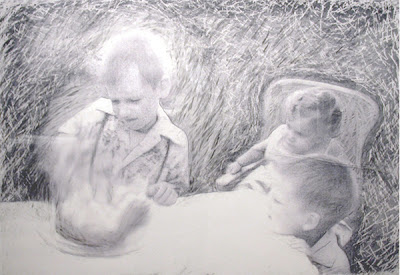When I introduced Studio RSVP a few months ago, I said we would journey back and forth looking at past and present to see if the more things change, the more they stay the same. This post will fast forward to 2000 and show work I called 'digital drawings'. I had been using computer technology for experimenting with images in the early 1990's, and by '95 had developed a series of photo-based work I began exhibiting. I used found and original photos, and was scanning them into the computer where I could use raster programs to exaggerate pixels, grains, dust and extraneous marks along with an electronic marking pad that I used for additional strokes and manipulating the image.
By 2000 I had developed a reasonable body of the work that was output as print/drawings on rag paper up to 60" inches. Using a monochromatic palette in the digital manipulation stage supported my interpretations of the dated subjects that related to past experience or memory, and allowed me to go into the final printed image and work with graphite, charcoal, and toned pencils to continue mark-making and manipulation. The end result looked photographic at a distance, but faded into a haze of marks, pixels and grains as the viewer approached the surface. The images seemed to dissolve as the viewer drew closer. I was interested in the ever-growing world of images captured in photographic stills and motion that insinuated the possibility of holding on to some past thing, and in some absurd way placing it in the present. Photographic images tend to be promoted as a way of slowing time with an on-going effort to grasp at the ephemeral.
Posted here is a selection of work from the 'traces' series from 2000, that after being stored for ten years, was recently selected for the retrospective exhibition 'TRIENNIAL Revisited' at 701 Center for Contemporary Art in Columbia, South Carolina. The South Carolina TRIENNIAL Exhibitions were organized by the South Carolina Arts Commission and the South Carolina State Museum between 1992 and 2004, and exhibited at the State museum. I was most fortunate to have been included in four of the five total exhibitions. TRIENNIAL Revisited is a juried exhibition from those five previous exhibits, and serves as a prelude and historical context for what will become the 701 CCA South Carolina Biennial.
 |
' sweet tea ' size: 28 X 40" digitally manipulated photo, print on rag paper, graphite © 2000 |
 |
' high of 98˚ ' size: 36 X 31" digitally manipulated photo, print on rag paper, graphite © 2000 |
 |
' shared reality ' size: 43 X 32" digitally manipulated photo, print on rag paper, graphite © 2000 |
 |
' inherent ambiguity ' size: 28 X 37" digitally manipulated photo, print on rag paper, graphite © 2000 |








